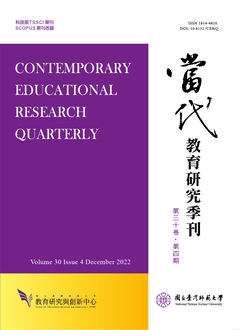

本研究主要是以先前研究所建立的補充性「戲劇課程架構」之「戲劇內涵Ⅱ──戲劇創作能力之應用」,建構並實驗出一套適用於國小表演藝術課程之「評分規範」。本篇論文以「低年級」課程為例,希望聚焦探討表演藝術能力指標之轉化歷程及其在現場運用的情形。研究中嘗試運用文獻中之建議,將表演藝術「能力指標」及「戲劇創作能力之應用」的內容進行轉化,發展「評分規範」初稿。之後,研究團隊至國小現場進行預試與修正工作。接著,再對17位教師進行訓練以建立評分共識,並回到現場進行檢測,以了解規範的使用情形,並提供回饋意見。透過循環性地教學、討論、反思與記錄的過程,「評分規範Ⅱ」的內容持續地修正。研究結果發現,除了對能力指標的轉化及教師共識的運作歷程更了解外,其結果也提供了「評分規範初稿」修訂的參考。其中幾個重要的修訂,例如:刪除「對話」向度,並將其內容融入「對戲劇情境接受的程度」與「角色」中;強調「角色」向度中動作、表情及口語等描述的明確性;釐清「回映」向度,以學生對於戲劇經驗的反省為主;重視「情節」向度中,學生表現的實質深度而非頻率的高低。最後,在教師進入現場實作後,又建議增加「完成任務的能力」及「參與活動的專注程度」等兩個向度。</p>
This research aims to develop and experiment a set of Scoring Rubrics in Drama Strand II for elementary school students based on the supplementary "Drama curriculum" developed by previous researchers. This paper will focus its discussion on the transformation process and practical issues (use primary grades as example). The first draft of the Rubrics was established through comparing the learning objective of the national curriculum with the new supplementary ones. It was then brought to the elementary classroom for testing and revising. After that, 17 teachers were invited to join the research to build up the Rubrics and went back to their own classroom for further testing and revising. Through circular actions between classroom teaching and team discussions, the final draft was done. Discussions in the process of coming to consensus offered good feedback to revise the drafted rubrics. Major revisions of the Scoring Rubrics are: integrating the content of "dialogue" into two other items— "accepting drama situations" and "role;" more clear descriptions is needed on "role;" "reflection" is different from "response;" "plot" needs to be focused on "quality" rather on "frequency" of the students' performance. Two new dimensions were added to the Rubrics. They are "ability to finish the task" and "concentration in the activity."

本著作係採用創用 CC 姓名標示-非商業性 3.0 台灣 授權條款授權.
本刊國立台灣師範大學教育研究與創新中心
106台北市和平東路一段162號 | 電話: 02-7749-3670 | E-mail: cerecerq@gmail.com
教創中心 | 師大 | 電子報 | 線上投審系統
本刊由國家科學及技術委員會人文社會科學研究中心補助經費
© 2014 CERI-NTNU
